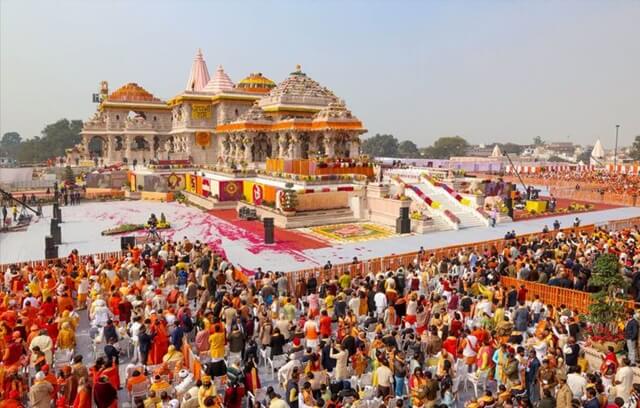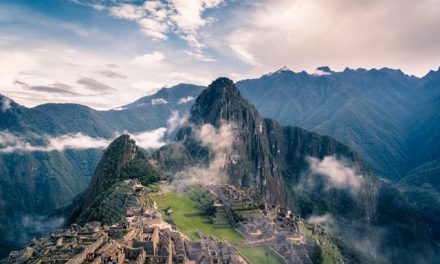Ayodhya, the ancient city of India, has a lot of cultural, spiritual, and historical significance. After 500 years of waiting, the Renaissance has come to Ayodhya. Lord Ram came to his homeland after several disputes between Hindus and Muslims. The dream of all Indians came true with the consecration of Ayodhya on January 22, 2024. And it is the best time to visit Ayodhya and indulge in its rich culture and spirituality. And also visit the beautiful places surrounding Ayodhya.
By reading this article, you will know everything about Ayodhya that is needed for your travel, like how to reach there, nearby airports, and surrounding attractions.
All about for your Ayodhya trip in 2024
If you are planning a visit to Ayodhya, then never miss a visit to nearby places in Ayodhya that are in very close proximity, and interestingly, some places are within walking distance. Here is the list of places to visit in Ayodhya:
- Saryu Ghat
- Ram ki Paidi
- Hanuman Garhi
- Rajdwar Mandir
- Dashrath Mahal
- Kanak Bhavan
- Guptar Ghat
- Bharat Kund
- Tulsi Smarak Bhavan Museum
- Sri Maniram Das Chavani
- Nageshwarnath Temple
- Ammaji Mandir
How to reach Ayodhya
You can reach Ayodhya from anywhere across the country, as every mode of transport is available to reach here. Also recently, Shri Narendra Modi inaugurated Maharshi Valmiki International Airport on December 30, 2023, at Ayodhya. Bus services, also provided by the State Transportation Corporation, are accessible at any time of the day or night.
As the place is accessible from the region of the country, here are the distances from different places to reach Ayodhya.
Although it is located 150 kilometres away from Ayodhya, Lucknow International Airport is the closest airport. It is approximately 158 kilometres away from Gorakhpur Airport, 172 kilometres away from Prayagraj Airport, and 224 kilometres away from Varanasi Airport.
A brief history of Ayodhya
People believe that Lord Rama, who is a central character in the Hindu epic Ramayana, was born in Ayodhya. For Hindus, the city is very important religiously. As Ayodhya moved into the Middle Ages, it saw a number of dynastic rulers and cultural growth.
During this time, the city was a hub for art, architecture, and philosophy. Ayodhya changed during the Mughal era. Building the Babri Masjid in the 1600s added to the variety of buildings in the city, showing how the Mughals changed the landscape.
When the mosque called Babri Masjid was built in Ayodhya, it caused a lot of trouble between Hindus and Muslims. In 1992, a group of Hindu activists tore down the mosque, which caused a lot of trouble between different groups.
Court cases and political arguments about the site have gone on for a long time. Still, in 2019, the Supreme Court of India made an important decision that was meant to end the Ayodhya dispute.
A Hindu temple could be built on the disputed land, and a mosque could be built on a different piece of land that was also given to that purpose. The goal of this decision was to end the long-running argument and promote peace between religions.
Ram Mandir: places to visit in Ayodhya
The Ram Mandir is a Hindu temple in Ayodhya, Uttar Pradesh, India, that was inaugurated on January 22, 2024. It is located at the site of Ram Janmabhoomi, which is called the birthplace of Lord Rama. The site is the former location of the Babri Masjid, which was built after the demolition of an existing temple.

Now the Ram Mandir was built at this Ram Janam Bhoomi. The Hon’ble Prime Minister of India, Narendra Modi, laid the ceremonial foundation stone of a new temple believed to be the birthplace of Lord Rama on August 5, 2020, in the city of Ayodhya.
Indians all over the world are excited about the consecration of Ayodhya. and also every type of transportation is available to reach this place from across the country and other countries too.
Sarayu Ghat
Saryu Ghat, which is located on the edge of the Saryu River,. It is just 2km away from Railway Junction to Saryu Ghat and is just 20 rupees in share auto. The Saryu River is also known as the Ghaghara River. It is one of the cleanest riverside ghats I have ever seen.
One can take a bath at this place in the morning and start the journey to visit Ayodhya. The water is very cold. The aarti timings in the evening are 5:30 in the winter and 6:30 in the summer, which takes around half an hour.
After that, there is a one-hour light and sound laser show, which I would recommend you not miss. The best time to visit this ghat is during Deepawali. Ayodhya Deepavali is famous on an international level.
You can get a wonderful experience of boating and riverfront. Boating is 80 per person; you have to bargain with the boatmen.
Ram ki Paidi:
Ram Ki Paidi is a historical ghat along the banks of the Sarayu River. It is associated with the legend of Lord Rama and is a significant pilgrimage site for Hindus. Ram ki Paidi is situated near the Naya Ghat in Ayodhya. It’s just 500m from Naya Ghat; you can come here by foot, enjoying the views of Ayodhya.
The ghat is well-known for its grand steps and frequently used by devotees for religious rituals and ceremonies. It holds immense cultural and religious importance in the Hindu tradition. When you take a walk along it, its a different experience in itself. It’s so calm, with the breeze from Maa Saryu flowing along it.
There are many pumps that pull water from the Saryu River into Ram Ki Paidi, and it lights up with full-colour lights and the view is mesmerising. Earlier, it used to be a dirty place with garbage all around but now it has been transformed drastically.
Hanuman Garhi: places to visit in Ayodhya
Hanuman Garhi is a 10th-century Hanuman temple in Uttar Pradesh, India. It is located near Ram Janmabhoomi, which is just 500m. It is one of the must-visit places in Ayodhya. Don’t visit in the summer; it’s much more crowded.
Hanuman Garhi is a stunning temple with Ramayana history. Hanuman Garhi must be visited before visiting Ram Mandir. Due to increased tourism, expect wait times of 30–60 minutes on weekdays and over an hour on weekends.
There are 76 steps to climb in order to reach the temple, which is on a hill. The main temple has a beautiful Bal (young) idol sitting on Maa Anjani’s lap.
If you are visiting Ayodhya, then it must be on your visit list. Since this temple is famous, there are many prasad, food, and other shops nearby. No reservation or entry fee is required for this temple.
Rajdwar Mandir:
It is one of the important landmarks of Ayodhya, located near Hanuman Garhi within just 270 m, which means you can walk. From far away, you can see this beautiful shrine with a high, tapering shikhar, which is built on higher ground. The temple is dedicated to Lord Ram.
It is a very historical place and gives you a very calm and devotional feel. Actually, it is not the main attraction of Ayodhya, but it is a great place to visit.
Dashrath Mahal: places to visit in Ayodhya
Located in the heart of the city, in Ramkot Ayodhya, in Faizabad, Dashrath Bhavan is the original residence of King Dashrath, the ruler of Ayodhya and father of Lord Sri Ram. It is also known as Bada Darbar, Bada Asthan, or Badi Jagah.
It is a holy place for Hindu yatri who are visiting Ayodhya. You can visit this place after doing puja in Hanuman Garhi Temple, then take a straight path linked to this place, and Bharath Milap Temple is also on the way.
Believed to have housed childhood rama and King Dasharath’s capital, this place is decorated with beautiful paintings and intricate architecture and inside the palace, you will notice the Hindu monks praying to the Lord Rama by dancing and singing to achieve salvation.
You can easily visit Ramjanmabhumi and Kanak Bhawan from here. Markets are just outside the mahal so you can shop a little bit too.
Kanak Bhavan:
Kanak Bhawan is located in Tulsi Nagar, Ramkot, in Ayodhya. It is one of the most famous temples in Ayodhya and is a must-visit place in Ayodhya. According to our epic, the Ramayana, it is believed that this bhawan was gifted to Devi Sita by Kaikei immediately after her marriage to Lord Ram.
Additionally, the locals told me, Nak Mahaluns is a kitchen with affordable prices for the general public, and one can purchase the parshad by paying the price. The architecture was good and one thing that was common in most of the places I visited in Ayodhya was the grand entrances to the temples.
Visiting Timings:
Limited Timings: 8:00 AM to 11:00 AM and 4:30 PM to 9:00 PM
Aarti Timings:
Summers: 8:00 AM to 9:00 AM and 7:00 PM to 8:00 PM
Winters: 8:30 AM to 9:30 AM and 6:30 PM to 7:30 PM
Guptar Ghat:
Gupthar Ghat is one of the best and most peaceful places in Ayodhya. It is a hidden gem of Ayodhya, where spirituality and serenity meet. The soothing chants, bhajans, and presence of devoted individuals create a divine atmosphere. It is a must-visit for locals and visitors alike.
You must visit this place on your visit to Ayodhya. The ancient temple located here is the place where Lord Rama dissolved into the Sarayu River (Jal Samadhi) and emerged as Lord Vishnu in full form. The dedicated priest at the temple narrated to us the sequence of that beautiful story, quoting the Skanda Purana.
Bharat Kund: places to visit in Ayodhya
It is situated about 20 kilometres from Ayodhya, the birthplace of Rama, in the state of Uttar Pradesh, India. This is right on the main road so you should not miss it. One must include this place in their Ayodhya visit. Bharat Kund is on the way between Ayodhya and Allahabad.
The Bharat Kund, also known as the Nandigram, is believed to be the place from which Bharat used to rule over Kosala Kingdom on behalf of Lord Rama, keeping his wooden slippers on a platform as a symbol.
The main temple, Shri Bharat Hanuman Milan Mandir, has me in tears. Here, you can witness the unique idols of Bharat and Hanuman hugging each other in the nearby temple.
Tulsi Smarak Bhavan Museum:
Tulsi Smarak Bhawan is a must-visit destination for anyone interested in Hindu mythology, literature, and history. It is a place of great significance and reverence for Hindus, and it is a testament to the rich cultural heritage of India. The museum showcases the great works of Goswami Tulsidas, known for his great work on Ramcharithmanas.
Tulsi Smarak Bhawan was built to explore different paintings and murals. Popularly famous for paintings and arts. We received a lot of visits from both foreigners and locals, which was wonderful for us. It helps us understand the Ramayana with paintings easily.
Sri Maniram Das Chavani:
This place is in front of Shri Valmiki Ramayana Bhavan and is also known as Chhoti Chavani. Mahant Shri Baba Maniram Das Ji was responsible for the establishment of this place. These days, his disciples are in charge of managing this location. This location is also the home of Mahant Shri Nityagopal Das ji, who is also the president of the Shri Ram Janmbhoomi organization.
When it comes to Ayodhya’s ashrams, it is among the oldest. Every day, the ashram provides free lunch to a large number of sadhus and guests, and devotees donate generously whenever they are in this location.
One of the vessels in this kitchen is large enough to fry two people in a single kadhai, and the hearth is so large that it is comparable to the height of a man’s shoulder. Also welcome to stay here are devotees.
Nageshwarnath Temple: places to visit in Ayodhya
My attention was drawn to the Nageshwarnath Temple. Before anything else, the historical significance of the temple piqued my interest because it is thought to be one of the oldest temples in the city. When I entered the building,
The building was an architectural marvel with intricate details adorning every angle, which left me in awe. On top of that, the tranquil atmosphere made for an ideal environment for contemplation and prayer. The transcendental atmosphere also struck awe in me, emphasising the temple’s significance within Ayodhya’s religious landscape.
To summarise, the Nageshwarnath Temple is a standing testament to the profound heritage and spiritual significance of Ayodhya. It provides visitors with an experience that is both profound and enriching.
Ammaji mandir:
A temple in Ayodhya, Uttar Pradesh, India, that is rooted in South Indian culture. Ammaji Mandir was constructed in 1904. In order to spread the greatness of the Lord (God) Sriram and SRI RAMAYANA, the Ithihasa Puranam of Sriram, the Srirama Navami festival has been celebrated on a grand scale for the past five years by the trust that was established for the purpose of developing the temple.
This temple is a must-see. It is possible to have a peaceful darshan of Lord Rama at one of the 108 Divya Desam temples, which is well maintained and has a lower number of visitors.
Conclusion:
In conclusion, Ayodhya is a special place with lots of stories from the past. You can visit the river, the temples, and walk through the old streets. The air is nice, and you can feel the history in every step you take. Ayodhya is not just a place to see; it’s like a peaceful journey for your heart and soul. You’ll find peace, stories, and a connection to a really old and cool culture. I hope your visit to Ayodhya is full of good memories and a happy feeling that stays with you for a long time.
Thankyou for reading For more travel updates, visit the Journey Index.





